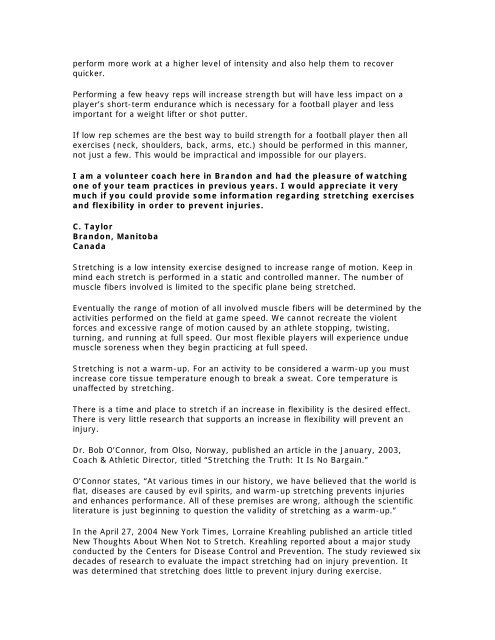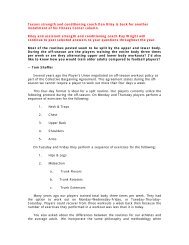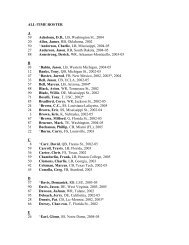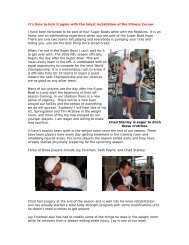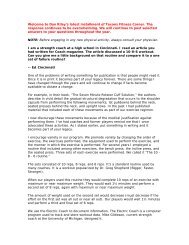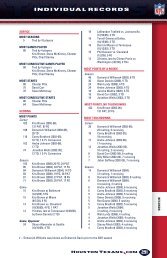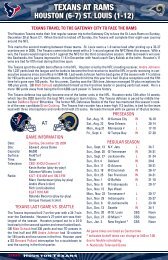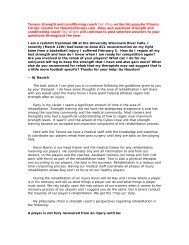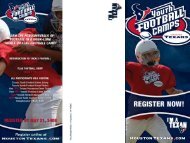Texans strength and conditioning coach Dan Riley writes his ...
Texans strength and conditioning coach Dan Riley writes his ...
Texans strength and conditioning coach Dan Riley writes his ...
You also want an ePaper? Increase the reach of your titles
YUMPU automatically turns print PDFs into web optimized ePapers that Google loves.
perform more work at a higher level of intensity <strong>and</strong> also help them to recoverquicker.Performing a few heavy reps will increase <strong>strength</strong> but will have less impact on aplayer’s short-term endurance which is necessary for a football player <strong>and</strong> lessimportant for a weight lifter or shot putter.If low rep schemes are the best way to build <strong>strength</strong> for a football player then allexercises (neck, shoulders, back, arms, etc.) should be performed in t<strong>his</strong> manner,not just a few. T<strong>his</strong> would be impractical <strong>and</strong> impossible for our players.I am a volunteer <strong>coach</strong> here in Br<strong>and</strong>on <strong>and</strong> had the pleasure of watchingone of your team practices in previous years. I would appreciate it verymuch if you could provide some information regarding stretching exercises<strong>and</strong> flexibility in order to prevent injuries.C. TaylorBr<strong>and</strong>on, ManitobaCanadaStretching is a low intensity exercise designed to increase range of motion. Keep inmind each stretch is performed in a static <strong>and</strong> controlled manner. The number ofmuscle fibers involved is limited to the specific plane being stretched.Eventually the range of motion of all involved muscle fibers will be determined by theactivities performed on the field at game speed. We cannot recreate the violentforces <strong>and</strong> excessive range of motion caused by an athlete stopping, twisting,turning, <strong>and</strong> running at full speed. Our most flexible players will experience unduemuscle soreness when they begin practicing at full speed.Stretching is not a warm-up. For an activity to be considered a warm-up you mustincrease core tissue temperature enough to break a sweat. Core temperature isunaffected by stretching.There is a time <strong>and</strong> place to stretch if an increase in flexibility is the desired effect.There is very little research that supports an increase in flexibility will prevent aninjury.Dr. Bob O’Connor, from Olso, Norway, published an article in the January, 2003,Coach & Athletic Director, titled “Stretching the Truth: It Is No Bargain.”O’Connor states, “At various times in our <strong>his</strong>tory, we have believed that the world isflat, diseases are caused by evil spirits, <strong>and</strong> warm-up stretching prevents injuries<strong>and</strong> enhances performance. All of these premises are wrong, although the scientificliterature is just beginning to question the validity of stretching as a warm-up.”In the April 27, 2004 New York Times, Lorraine Kreahling published an article titledNew Thoughts About When Not to Stretch. Kreahling reported about a major studyconducted by the Centers for Disease Control <strong>and</strong> Prevention. The study reviewed sixdecades of research to evaluate the impact stretching had on injury prevention. Itwas determined that stretching does little to prevent injury during exercise.


